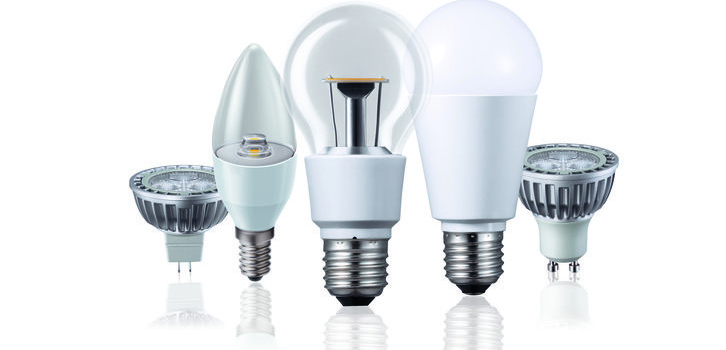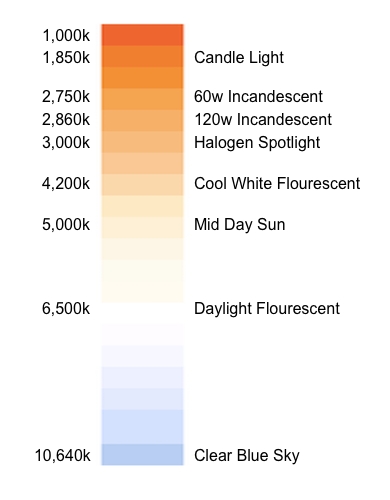
Understanding lighting
Before looking at buying LED lighting for your home, it is really important to understand how light works and what makes some light different to others.
The importance of light in the home cannot be understated; about 80% of our sensory input is through our eyes, therefore if the lighting in your home is wrong it will obviously have a huge negative impact. In addition, recent studies suggest that lighting has an impact on health and wellbeing. Good lighting makes people feel both mentally and physically better so it is worth getting right!
What determines the type of light produced by a lamp?
The light produced from a lamp is dependant on three things: colour temperature, colour rendering and lumen output.
Colour temperature
Different types of light bulb tend to produce different colours of light. For example, a traditional incandescent bulb tends to glow a warm yellow colour, while a strip light in an office tends to produce a very white light. The colour of light produced by a bulb is known as the colour temperature – or more correctly, the correlated colour temperature (CCT).
The best way to envisage this is to imagine heating a piece of iron. Initially it will be a dark dull colour, but as you heat it, it will begin to glow orange and as you take the temperature up even further it becomes a brighter white. The CCT refers to the colour at a particular temperature, so the hotter the temperature the brighter (and whiter) the light colour.
Now, the CCT is actually determined from the colour changes of a ‘black body radiator’ as it is heated – but obviously the piece of iron is a much easier concept to get your head around!
So the colour temperature is simply a numerical value assigned to the colour emitted from a light source depending on the temperature (measured in degrees Kelvin). In the chart on the right, you can see examples of different types of bulbs and their colour temperature.
Please note that the chart is used just to illustrate the point; different bulbs can operate at slightly different colour temperatures, but this can certainly be used as a guide.
Typically, we refer to low colour temperature as being ‘warm’ in appearance, while high colour temperature is referred to as ‘cool’ in appearance. If you consider your home, it is likely to be dominated by warm light – halogen GU10 spotlights and traditional incandescent bulbs, conversely offices tend to be lit by more cold light, including things like fluorescent tubes.
Colour rendering
Colour rendering is the ability of a light source to give good colour representation of the colour it is illuminating. It is measured on a scale of Ra 0–100 (Ra is sometimes replaced with CRI). Ra 100 is considered the best and this is equivalent to the rendering provided by daylight, hence many work places are now using daylighting as a matter of course.
The European Union’s standard for workplace lighting (EN 12464-1:2011) dictates that lighting needs to be a minimum Ra 80. There is obviously no such standard for the home, but the higher the Ra number, the more vivid and lively representation of the object being illuminated. It is possible to get lights with Ra 90+ but as you might expect, the bulbs will cost considerably more.
Lumen output
The lumen is a unit of measurement for the brightness of light. A bulb with a higher number of lumens will produce a brighter light, while fewer lumens results in a dimmer light.
In the past, consumers relied on watts to get a feel for the brightness of a bulb. A 100w incandescent bulb is far brighter than a 40w bulb, for example. However since the advent of low energy lighting, comparing wattage just isn’t feasible since a 5w LED might produce the same number of lumens as an equivalent 40w incandescent bulb.
In the table on the right, you can see a list of typical bulbs and their relative luminous efficiency – which is simply the lumens you can expect per watt. The traditional incandescent bulbs fare worst and the new LEDs are the best.
When replacing your existing bulbs with new LEDs, we recommend using the lumen as a comparison, to ensure your new LED bulbs have a similar level of brightness.
Lux – measuring the intensity of light
Remember that the lumen is a unit of measurement for the brightness of light.
Regardless of how bright a light is, if you are a long way from it, it will provide less light intensity than if you stood right next to it.
Lux is the measure of the apparent intensity of light hitting or passing through a surface at a given distance. A light source 1 metre away will appear far brighter than the same light source from 100 metres way.
1 lux is equal to 1 lumen per square metre, so if you have 1000 lumens concentrated on an area of 1m2 then the area will be light up with an illuminance of 1000 lux.
If you had the same 1000 lumen bulb concentrated on an area of 10m2, the area would be dimmer, since the illuminance would only be 100 lux.

What this all means for the lighting in your home
In the majority of cases, we recommend going for a bulb with a colour temperature of between 2,700k and 4,200k. This is the equivalent to a more traditional incandescent or halogen bulb.
Having said all that, the colour temperature of the lighting you opt for is a very personal preference, but we do recommend trying a few different bulbs to see which you prefer before investing in a whole load of them.
One thing that you do need to ensure is that you opt for the same colour temperature in each area. This means that when you bulk-buy bulbs for a targeted area they are the same colour temperature and ideally the same bulb (this will ensure they have the same lifespan which can reduce maintenance costs).
In terms of colour rendering, as mentioned, bulbs that have a higher colour-rendering figure will cost more. In stairwells and corridors, you can get away with cheaper bulbs that don’t offer the same colour rendering capabilities as ones you might want in the living room or kitchen.
















thank’s that was so helpfull